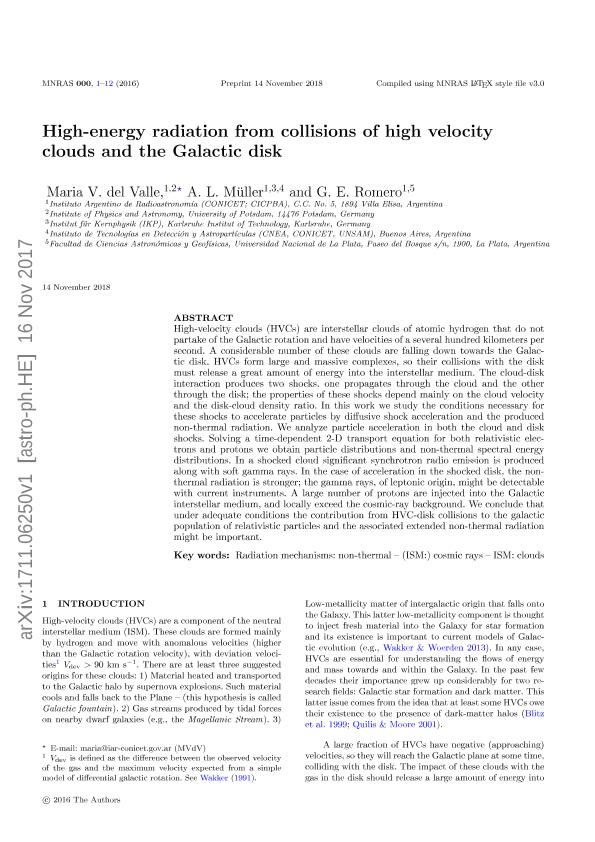Mostrar el registro sencillo del ítem
dc.contributor.author
del Valle, Maria V.
dc.contributor.author
Müller, A. L.
dc.contributor.author
Romero, Gustavo Esteban

dc.date.available
2019-08-28T19:36:36Z
dc.date.issued
2018-04
dc.identifier.citation
del Valle, Maria V.; Müller, A. L.; Romero, Gustavo Esteban; High-energy radiation from collisions of high-velocity clouds and the Galactic disc; Oxford University Press; Monthly Notices of the Royal Astronomical Society; 475; 4; 4-2018; 4298-4308
dc.identifier.issn
0035-8711
dc.identifier.uri
http://hdl.handle.net/11336/82423
dc.description.abstract
High-velocity clouds (HVCs) are interstellar clouds of atomic hydrogen that do not follow normal Galactic rotation and have velocities of a several hundred kilometres per second. A considerable number of these clouds are falling down towards the Galactic disc. HVCs form large and massive complexes, so if they collide with the disc a great amount of energy would be released into the interstellar medium. The cloud-disc interaction produces two shocks: one propagates through the cloud and the other through the disc. The properties of these shocks depend mainly on the cloud velocity and the disc-cloud density ratio. In this work, we study the conditions necessary for these shocks to accelerate particles by diffusive shock acceleration and we study the non-thermal radiation that is produced. We analyse particle acceleration in both the cloud and disc shocks. Solving a time-dependent two-dimensional transport equation for both relativistic electrons and protons, we obtain particle distributions and non-thermal spectral energy distributions. In a shocked cloud, significant synchrotron radio emission is produced along with soft gamma rays. In the case of acceleration in the shocked disc, the non-thermal radiation is stronger; the gamma rays, of leptonic origin, might be detectable with current instruments. A large number of protons are injected into the Galactic interstellar medium, and locally exceed the cosmic ray background. We conclude that under adequate conditions the contribution from HVC-disc collisions to the galactic population of relativistic particles and the associated extended non-thermal radiation might be important.
dc.format
application/pdf
dc.language.iso
eng
dc.publisher
Oxford University Press

dc.rights
info:eu-repo/semantics/openAccess
dc.rights.uri
https://creativecommons.org/licenses/by-nc-sa/2.5/ar/
dc.subject
Cosmic Rays
dc.subject
Ism: Clouds
dc.subject
Radiation Mechanisms: Non-Thermal
dc.subject.classification
Astronomía

dc.subject.classification
Ciencias Físicas

dc.subject.classification
CIENCIAS NATURALES Y EXACTAS

dc.title
High-energy radiation from collisions of high-velocity clouds and the Galactic disc
dc.type
info:eu-repo/semantics/article
dc.type
info:ar-repo/semantics/artículo
dc.type
info:eu-repo/semantics/publishedVersion
dc.date.updated
2019-08-16T16:48:51Z
dc.journal.volume
475
dc.journal.number
4
dc.journal.pagination
4298-4308
dc.journal.pais
Reino Unido

dc.journal.ciudad
Londres
dc.description.fil
Fil: del Valle, Maria V.. Provincia de Buenos Aires. Gobernación. Comisión de Investigaciones Científicas. Instituto Argentino de Radioastronomía. Consejo Nacional de Investigaciones Científicas y Técnicas. Centro Científico Tecnológico Conicet - La Plata. Instituto Argentino de Radioastronomía; Argentina. Universitat Potsdam; Alemania
dc.description.fil
Fil: Müller, A. L.. Comisión Nacional de Energía Atómica; Argentina. Provincia de Buenos Aires. Gobernación. Comisión de Investigaciones Científicas. Instituto Argentino de Radioastronomía. Consejo Nacional de Investigaciones Científicas y Técnicas. Centro Científico Tecnológico Conicet - La Plata. Instituto Argentino de Radioastronomía; Argentina
dc.description.fil
Fil: Romero, Gustavo Esteban. Provincia de Buenos Aires. Gobernación. Comisión de Investigaciones Científicas. Instituto Argentino de Radioastronomía. Consejo Nacional de Investigaciones Científicas y Técnicas. Centro Científico Tecnológico Conicet - La Plata. Instituto Argentino de Radioastronomía; Argentina. Universidad Nacional de La Plata. Facultad de Ciencias Astronómicas y Geofísicas; Argentina
dc.journal.title
Monthly Notices of the Royal Astronomical Society

dc.relation.alternativeid
info:eu-repo/semantics/altIdentifier/url/https://academic.oup.com/mnras/article-abstract/475/4/4298/4876037
dc.relation.alternativeid
info:eu-repo/semantics/altIdentifier/doi/https://doi.org/10.1093/mnras/stx2984
Archivos asociados
